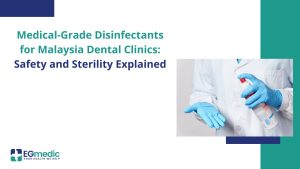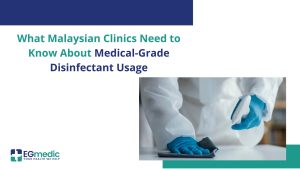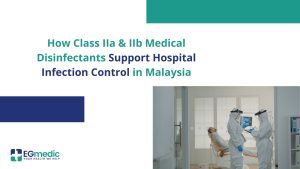Understanding Class IIa & IIb Disinfectants
In the context of medical devices and disinfectants, Class IIa and IIb refer to European Medical Device Regulation (MDR) classifications. These disinfectants are used in more invasive or high-risk environments than Class I products.
- Class IIa disinfectants are typically used for disinfecting non-invasive medical devices like ultrasound probes or surgical tables.
- Class IIb disinfectants are intended for invasive medical equipment such as endoscopes, surgical instruments, and dialysis machines.
Both types must demonstrate high antimicrobial efficacy, material compatibility, and user safety. EG Medic supplies a range of Class IIa and IIb disinfectants that are formulated for sensitive hospital and laboratory use, meeting the growing demand for certified solutions in Malaysia.
Essential Features of Effective Medical Disinfectants
To be truly effective in a clinical setting, Class IIa and IIb disinfectants must offer a combination of the following features:
- Broad-spectrum antimicrobial action: Must eliminate bacteria, viruses, fungi, and spores efficiently.
- Fast-acting formulas: Rapid disinfection time is critical in high-throughput hospital settings.
- Material compatibility: Should be safe for use on sensitive medical device surfaces without causing corrosion.
- Non-toxic and residue-free: Must be safe for patients and healthcare professionals, especially in surgical or ICU environments.
- Ready-to-use or easy-to-dilute: Convenient formats reduce errors in dilution and application.
EG Medic ensures that its products, such as Anios Clean Excel or Aniosyme DD1, feature the ideal chemical balance for high-level disinfection, fast turnaround, and safety in Malaysian healthcare settings.
Conclusion
Choosing the right Class IIa and IIb disinfectants in Malaysia is crucial to maintaining safety, hygiene, and regulatory compliance in medical environments. By prioritizing key features such as fast action, broad-spectrum efficacy, material compatibility, and adherence to international standards, healthcare providers can prevent infection and ensure safe patient care.







